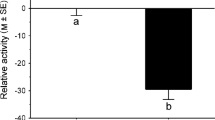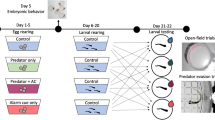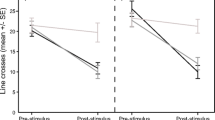Abstract
How individuals assess, respond and subsequently learn from alarm cues is crucial to their survival and future fitness. Yet this information is not constant through time; many individuals are exposed to different predators throughout their life as they outgrow some predators or move to habitats containing different predators. To maximise overall fitness, individuals should discriminate between different cues and respond and learn from only those that are relevant to their current ontogenetic stage. We tested whether juvenile spiny chromis, Acanthochromis polyacanthus, could distinguish between chemical alarm cues from conspecific donors of different ontogenetic stages and whether the cue ontogenetic stage of the cue donor affected the efficacy of learning about predators. Juveniles displayed a significant antipredator response when conditioned with juvenile chemical alarm cues paired with predator odour but failed to respond when conditioned with predator odour paired with either adult alarm cues or with saltwater. Subsequently, individuals only recognised the predator odour alone as a threat when conditioned with juvenile alarm cues. This demonstrates that prey may be highly specific in how they use information from conspecific alarm cues, selectively responding to and learning from only those cues that are relevant to their developmental stage.


Similar content being viewed by others
References
Almany G, Webster M (2006) The predation gauntlet: early post-settlement mortality in reef fishes. Coral Reefs 25:19–22
Bellwood DR, Hughes TP (2001) Regional-scale assembly rules and biodiversity of coral reefs. Science 292:1532–1534
Blumstein DT, Daniel JC (2004) Yellow-bellied marmots discriminate between the alarm calls of individuals and are more responsive to calls from juveniles. Anim Behav 68:1257–1265
Blumstein DT, Verneyre L, Daniel JC (2004) Reliability and the adaptive utility of discrimination among alarm callers. Proc R Soc Lond B 271:1851–1857
Brown GE, Smith RJF (1996) Foraging trade-offs in fathead minnows (Pimephales promelas, Osteichthyes, Cyprinidae): acquired predator recognition in the absence of an alarm response. Ethology 102:776–785
Brown GE, Adrian JC Jr, Patton T, Chivers DP (2001) Fathead minnows learn to recognize predator odour when exposed to concentrations of artificial alarm pheromone below their behavioural-response threshold. Can J Zool 79:2239–2245
Brown GE, Gershanec DL, Plata DL, Golub JL (2002) Ontogenetic changes in response to heterospecific alarm cues by juvenile largemouth bass are phenotypically plastic. Behaviour 39:913–927
Brown GE, Foam PE, Cowell HE, Fiore PG, Chivers DP (2004) Production of chemical alarm cues in convict cichlids: the effects of diet, body condition and ontogeny. Ann Zool Fenn 41:487–499
Carreau-Green ND, Mirza RS, Martinez ML, Pyle GG (2008) The ontogeny of chemically mediated antipredator responses of fathead minnows Pimephales promelas. J Fish Biol 73:2390–2401
Chivers DP, Smith RJF (1998) Chemical alarm signalling in aquatic predator-prey systems: a review and prospectus. Ecoscience 5:338–352
Connell SD (2000) Is there safety-in-numbers? Oikos 88:527–532
Dalesman S, Rundle SD, Bilton DT, Cotton PA (2007) Phylogenetic relatedness and ecological interactions determine anti-predator behaviour. Ecology 88:2462–2467
Feeney WE, Lönnstedt OM, Bosiger YJ, Martin J, Jones GP, Rowe RJ, McCormick MI (2012) High rate of prey consumption in a small predatory fish on coral reefs. Coral Reefs 31:909–918
Ferrari MCO, Trowell JJ, Brown GB, Chivers DP (2005) The role of learning in the development of threat-sensitive predator avoidance by fathead minnows. Anim Behav 70:777–784
Ferrari MCO, Capitania-Kwok T, Chivers DP (2006) The role of learning in the acquisition of threat-sensitive responses to predator odours. Behav Ecol Sociobiol 60:522–527
Ferrari MCO, Chivers DP (2009) Sophisticated early life lessons: threat-sensitive generalization of predator recognition by embryonic amphibians. Behav Ecol 63:1369–1375
Ferrari MCO, Wisenden BD, Chivers DP (2010) Chemical ecology of predator-prey interactions in aquatic ecosystems: a review and prospectus. Can J Zool 88:698–724
Golub JL, Brown GE (2003) Are all signals the same? Ontogenetic change in the response to conspecific and heterospecific chemical alarm signals by juvenile green sunfish (Lepomis cyanellus). Behav Ecol Sociobiol 54:113–118
Golub JL, Vermette V, Brown GE (2005) Response to conspecific and heterospecific alarm cues by pumpkinseeds in simple and complex habitats: field verification of an ontogenetic shift. J Fish Biol 66:1073–1081
Harvey MC, Brown GE (2004) Dine or dash? Ontogenetic shift in the response of yellow perch to conspecific alarm cues. Environ Biol Fish 70:345–352
Helfman GS (1989) Threat-sensitive predator avoidance in damselfish–trumpetfish interactions. Behav Ecol Sociobiol 24:47–58
Holmes T, McCormick MI (2010) Size-selectivity of predatory reef fish on juvenile prey. Mar Ecol Prog Ser 399:273–283
Lima SL, Bednekoff PA (1999) Temporal variation in danger drives antipredator behaviour: the predation risk allocation hypothesis. Am Nat 153:649–659
Lima SL, Dill LM (1990) Behavioral decisions made under the risk of predation—a review and prospectus. Can J Zool 68:619–640
Lönnstedt OM, McCormick MI (2011) Chemical alarm cues inform prey of predation threat: the importance of ontogeny and concentration in a coral reef fish. Anim Behav 82:213–218
Lönnstedt OM, McCormick MI, Meekan MG, Ferrari MCO, Chivers DP (2012) Learn and live: predator experience and feeding history determines prey behaviour and survival. Proc R Soc B. doi:10.1098/rspb.2011.2516
Manassa RP, McCormick MI (2012) Social learning improves survivorship at a life history transition. Oecologia. doi:10.1007/s00442-012-2458-x
Marcus J, Brown GE (2003) Response of pumpkinseed sunfish to conspecific chemical alarm cues: an interaction between ontogeny and stimulus concentration. Can J Zool 81:1671–1677
Mirza RS, Chivers DP (2002) Brook charr (Salvelinus fontinalis) can differentiate chemical alarm cues produced by different age/size classes of conspecifics. J Chem Ecol 28:555–564
Mirza RS, Chivers DP (2003) Response of juvenile rainbow trout to varying concentrations of chemical alarm cue: response thresholds and survival during encounters with predators. Can J Zool 81:88–95
Nonacs P, Blumstein DT (2010) Predation risk and behavioural life history. In: Westneat DF, Fox CW (eds) Evolutionary behavioural ecology. Oxford University Press, New York, pp 207–224
Sih A, Ziemba R, Harding KC (2000) New insights on how temporal variation in predation risk shapes prey behaviour. Trends Ecol Evol 15:3–4
Thresher RE (1983) Environmental correlates of the distribution of planktivorous fishes in the One Tree reef lagoon. Mar Ecol Prog Ser 10:137–145
Acknowledgments
We would like to thank the staff at the JCU MARFU aquarium facility for their assistance and Christopher Goatley for providing comments on an earlier version of the manuscript. Funding was provided by the ARC Centre of Excellence for Coral Reef Studies (MIM).
Ethical standards
This research complies with current laws of Australia and was undertaken with approval of the James Cook University animal ethics committee (permit: A1067) and according to the University’s animal ethics guidelines.
Author information
Authors and Affiliations
Corresponding author
Additional information
Communicated by A. Pilastro
Rights and permissions
About this article
Cite this article
Mitchell, M.D., McCormick, M.I. Ontogenetic differences in chemical alarm cue production determine antipredator responses and learned predator recognition. Behav Ecol Sociobiol 67, 1123–1129 (2013). https://doi.org/10.1007/s00265-013-1537-2
Received:
Revised:
Accepted:
Published:
Issue Date:
DOI: https://doi.org/10.1007/s00265-013-1537-2




